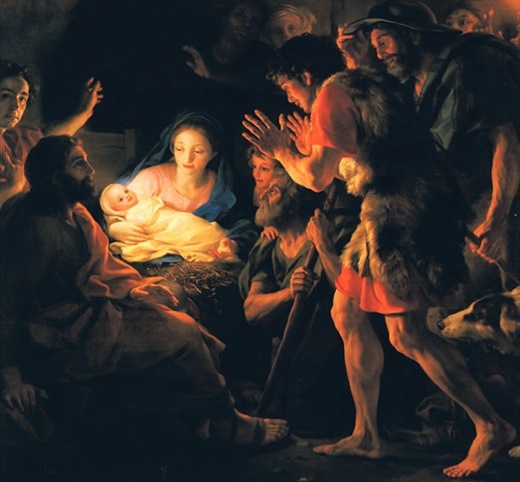 Image above: Detail of "Adoration of the Shepards" by Anton Raphael Mengs (circa 1750). From (http://www.abcgallery.com/M/mengs/mengs.html).
Image above: Detail of "Adoration of the Shepards" by Anton Raphael Mengs (circa 1750). From (http://www.abcgallery.com/M/mengs/mengs.html).
By now, if you hear just one more elevator-version of “The Christmas Song,” you may be ready to throw something other than those chestnuts on the open fire and bemoan the unending commercialization of the holiday season. Yet we should not throw our skeptical skills also on the Yule log and look uncritically at the stories and customs we may hold dear this time of year.
When did Christmas become such a commercial event?
Quite some time ago. Many holiday traditions are secular in origin and not religious at all. For example, Rudolph the Red-Nosed Reindeer began as a promotional character created by Robert May for the Montgomery Ward department store in 1939. And the Coca-Cola Company in the 1930s, appropriated the image of a jolly, ruddy-faced Santa for its commercial campaign to get people to drink its soda in the winter months, thereby establishing our contemporary portrayal of what originally was a much thinner St. Nick.
Many religious organizations, and some conservative commentators, created a furor several years ago claiming there was a “war on Christmas” brought about by such supposedly politically correct greetings as “Happy Holidays” and by failing to keep Christ in Christmas when using the shortened “Xmas.” However, the X in “Xmas” is not the same as the X in “X-Factor.” It is instead chi, the Greek letter representing Christ. Documents since at least the 11th century used X or XP to symbolize the word Christ (XP is from the Greek chi and rho, the first two letters of Christos) and Xt (for Christian). So a “Xmas” greeting actually continues that religious tradition.
One holiday custom is giving (or regifting!) a colorful red plant. Perhaps you’ve heard that the ubiquitous holiday bloom, Euphorbia pulcherrima, the poinsettia, may kill you if swallowed.
In reality, it’s fatal to your skeptical skills if you swallow the rumor that it is a poisonous plant. The Aztecs in the 15th century used the milky white sap from the plant to control fevers. While some people (especially those allergic to latex) may get skin irritation from the sap, the poinsettia is not poisonous if eaten. Native to Mexico, it was brought to the United States in the 1820s by Joel Roberts Poinsett, the first U.S. ambassador to Mexico. Poinsettia were sold commercially in the early 1900s by the Ecke family ranch near San Diego (where the majority of today’s poinsettia plants come from).
Earlier this month came the celebration of Hanukkah, another holiday replete with myths that deserve our skeptical eye. Hanukkah recalls the Jews’ rededication of the Temple in Jerusalem around 165 BCE after the Maccabees were victorious over the Syrian king. It was not created as a response to Christmas and although its date varies on our Gregorian calendar, it’s always the Hebrew calendar date of 25 Kislev.
Despite what many believe, Hanukkah is not a major holiday in religious Jewish households compared with Rosh Hashanah or Yom Kippur. Many people also mistakenly think that the familiar seven-candle menorah is used for the holiday. Actually, it’s a hanukkiyah, a nine-candleholder version used during the Hanukkah period. Gift giving and eating jelly doughnuts were not part of the historical record!
Even Kwanzaa, a seven-day African-American and Pan-African event created in 1966, must counter some popular myths. It is not a replacement for Christmas or a religious holiday. The celebration begins the day after Christmas and is based on the rituals of African harvest festivals. “Kwanzaa” is Swahili for “fresh fruits” and celebrates family, community and culture.
Scholarly research also provides us with some important ideas about the holiday season. A common misconception is the belief that suicide rates increase during this holiday time. Contrary to media reports and urban legends, suicide rates typically decline during the Christmas season. Research conducted in England also found that the number of incidents of deliberate self-inflicted harm, an indicator of depression, tended to be below average during Christmas week.
Whether you celebrate the secular or religious versions of the many winter holidays, it is impossible to avoid the visual and aural onslaught of Christmas music and imagery.
In an unusual 2001 research study, based on what is called the “White Christmas test,” students listened to white noise over headphones and were told to press a button when they believed they heard a recording of Bing Crosby’s “White Christmas” — even though this song was played only as they entered the soundproof room, not during the three minutes of white noise.
This test is based on hallucinatory research demonstrating that some people, perhaps those more prone to fantasy, tend to report auditory events that are suggested to them. In this study, 32 percent of the subjects said they heard “White Christmas” over their headphones; those students also scored higher on an index of fantasy proneness.
What this all means is that you are possibly hearing “White Christmas” as you finish this article even though you’re not in a shopping mall or elevator. So go ahead and throw some chestnuts on an open fire and sing it out. Happy Holidays and to all a good night.
.
No comments :
Post a Comment